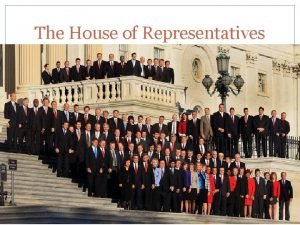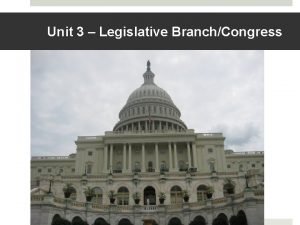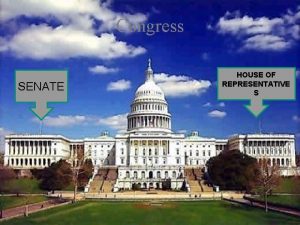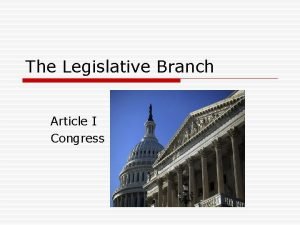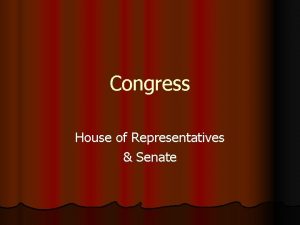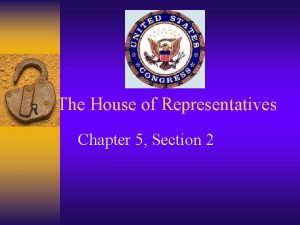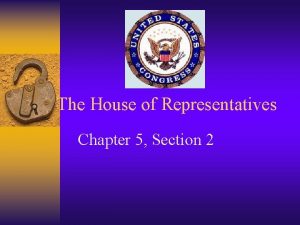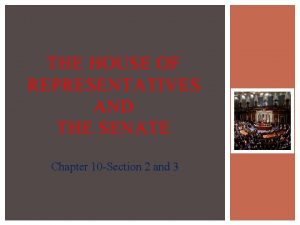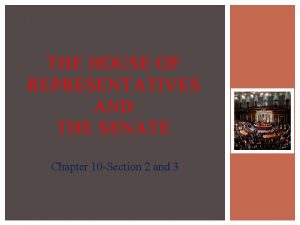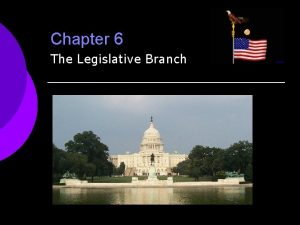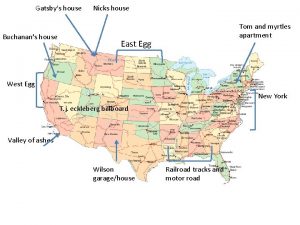The House of Representatives CHAPTER 10 SECTION 2






























- Slides: 30

The House of Representatives CHAPTER 10 SECTION 2


Starter Which States have the fewest number of House members; which state has the largest?

Objective Students will: 1) learn the size of the House as well as the term length and qualifications of members of the House; and 2) understand gerrymandering. The Main Idea: Members of the House, who can serve an unlimited number of two-year terms, represent districts of roughly equal proportion.

Guiding Question �How are the seats in the House distributed and what qualifications must members meet?

Question �Who elects individual members to the House of the Representatives?

Size of the House �Number of House seats: 435; (Congress sets the size of the House, not the Constitution); �*The Constitution provides that House seats be apportioned (distributed) among the States on the basis of their respective populations. * Proportional representation �So, which States have the larger voice?



Terms of Representatives �**Representatives are elected for two-year terms. ** � This short term means that the next election is always around the corner, so this makes Representatives pay close attention to “the folks back home. ” �There is no constitutional limit on the number of terms any member may serve. � It is actually unconstitutional for states to limit the number of terms their members of Congress may serve.

*Qualification of Representatives* Constitution provides that Representatives must be: 1) 2) 3) 25 years old; U. S. citizen for at least 7 years; and Reside in the represented State. Question: can a person born and raised in North Korea, who later moves to the U. S. and naturalizes to the country, becoming a U. S. citizen for at least 7 years, run for a House seat?


Reapportionment �The 435 House seats are reapportioned (redistributed) every ten years when the U. S. counts its population. This count is called the census. After each census, the number of representatives of any state may change based on changes in its population That is, if a state loses or gains citizens, it may lose or gain House seats. �Each of the 435 House seats (divided into districts) represents an average of over 700 k persons.

Elections �Elections of Representatives are held on the Tuesday following the first Monday in November of each even -numbered years. �Question: Give me the month, day, and year of our next election of representatives to the House.


Single-member districts �Single-member districts: voters in each district elect one of the State’s Representatives from among a field of candidates running for a seat in that district. �In the past, Congress gave States the option of electing its members by a general ticket system (atlarge elections where the whole state votes) or on a single-member district basis. �Congress scrapped the general ticket system in 1842.

Question �Why do you think States set up districts from which to elect representatives? �Do you think the city of Memphis as a whole has a different personality or different values than the city of Knoxville?

Redrawing Congressional Districts �Once Congress tells each State how many House seats it has, the State legislatures draw the boundaries of its electoral districts. Note: They are redrawn because population patterns shift. �States engage in gerrymandering, which is the drawing of electoral districts with the goal of maximizing the number of seats held by the party that controls the State’s legislature.





Gerrymandering (Democrats Control - 2003)

Gerrymandering (Republicans Control - 2013)

Gerrymandering Facts �Congressional districts must have substantially equal populations. �Gerrymandering solely on the basis of race is unconstitutional. �Supreme Court has stated that nothing in the Constitution prevents a State from redrawing district lines to give advantage to the party in control of the legislature.

Gerrymandering Group Handout �Chapter 10, Section 2, Core Worksheet

Exit Ticket 1) Whom does each member of the House represent? 2) What is a district? 3) If your state has more than one representative in the House, do you get to vote for each representative from your state? 4) Why are district lines redrawn? 5) How can gerrymandering benefit the party in control?

Is the House truly the “People’s House? ”


 Twitter
Twitter Lesson 1 - the structure of congress
Lesson 1 - the structure of congress The senate and house of representatives
The senate and house of representatives House of representatives gym
House of representatives gym The senate and house of representatives
The senate and house of representatives The senate and house of representatives
The senate and house of representatives How many representatives per state
How many representatives per state Representatives per state
Representatives per state Classes in phylum arthropoda
Classes in phylum arthropoda Section quick check chapter 10 section 1 meiosis answer key
Section quick check chapter 10 section 1 meiosis answer key Role of acceptance and discount house
Role of acceptance and discount house St vincents housing association
St vincents housing association Banished boarding house vs house
Banished boarding house vs house My house shall be called a house of prayer
My house shall be called a house of prayer They went house to house
They went house to house Branded house house of brands
Branded house house of brands Hình ảnh bộ gõ cơ thể búng tay
Hình ảnh bộ gõ cơ thể búng tay Ng-html
Ng-html Bổ thể
Bổ thể Tỉ lệ cơ thể trẻ em
Tỉ lệ cơ thể trẻ em Chó sói
Chó sói Chụp phim tư thế worms-breton
Chụp phim tư thế worms-breton Alleluia hat len nguoi oi
Alleluia hat len nguoi oi Các môn thể thao bắt đầu bằng tiếng nhảy
Các môn thể thao bắt đầu bằng tiếng nhảy Thế nào là hệ số cao nhất
Thế nào là hệ số cao nhất Các châu lục và đại dương trên thế giới
Các châu lục và đại dương trên thế giới Công của trọng lực
Công của trọng lực Trời xanh đây là của chúng ta thể thơ
Trời xanh đây là của chúng ta thể thơ Cách giải mật thư tọa độ
Cách giải mật thư tọa độ 101012 bằng
101012 bằng độ dài liên kết
độ dài liên kết
